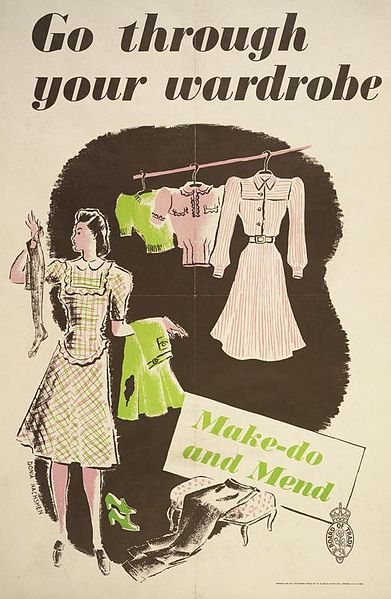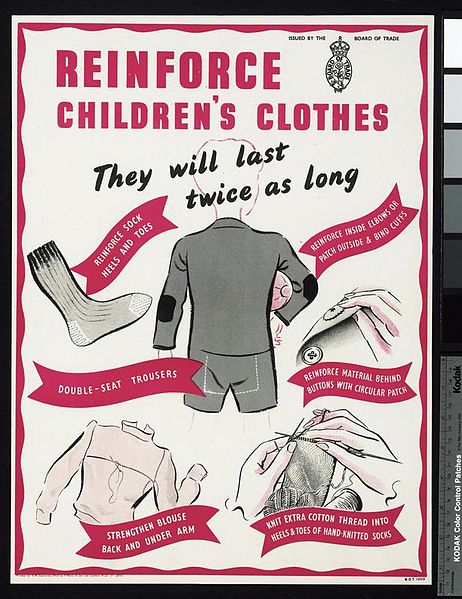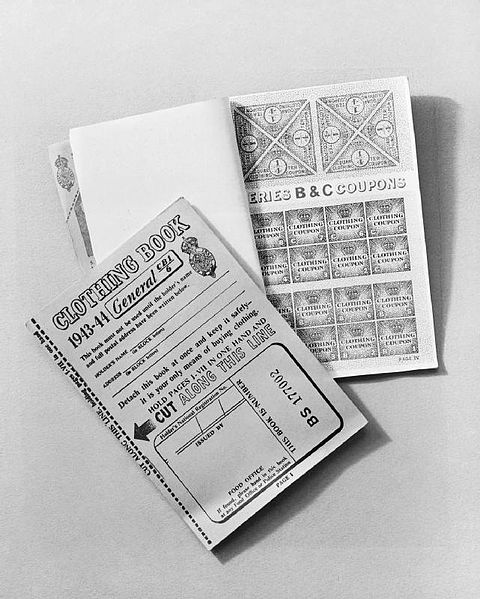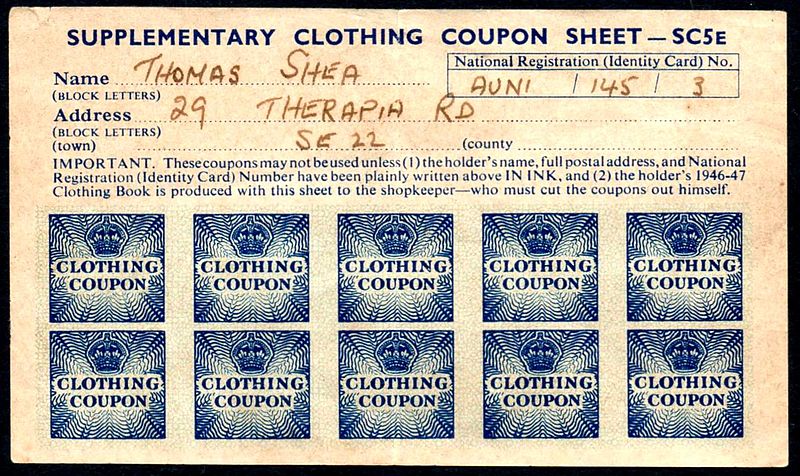Do the words
clothes rationing
send a shudder down your spine?
Before you run off to lock your closet, let me assure you that this World War II practice is not being reinstated.
Well, not yet, anyway.
But you might find (once the initial shock of the notion has faded) that you are pondering its practicality.
Hmmm …

Image courtesy of the Board of Trade, artist Donia Nachshen, Her Majesty’s Stationery Office via Wikimedia Commons
Clothes rationing was in fashion (euphemistically speaking) in the U.K. from 1941 to 1949, when manufactured commodities were limited. At first, each adult in the country received an annual allotment of 60 coupons, but as time went on, the number was reduced to 48. Kids were given an extra 10 coupons each to account for growth.
According to the sustainable fashion hub Ecouterre, “You had to be judicious in your selections; a petticoat or slip ‘cost’ three coupons, a woolen dress eleven, and a men’s overcoat an extravagant thirteen. Even a pair of socks required at least one coupon.”
The kicker was that a coupon didn’t actually pay for anything—it simply represented permission to purchase a certain quantity with one’s own limited finances.
Necessity, which we credit as the Mother of Invention, spurred a national movement of Make Do and Mend, of which my grandmother pitched in full bore. Men’s suits became children’s coats (I was the recipient of one of them) and worn trousers became vests. You see, my grandmother was of the era in which she showed up for work every day (after her children were raised) in a fancy hat and white gloves (required for her job) as a creator of sewing patterns in Denver, Colorado.

Image courtesy of Board of Trade, H Manly and Son Ltd, London N22, and Her Majesty’s Stationery Office via Wikimedia Commons
To advocate the idea of a “substitution and conversion” economy, the Ministry of Supply produced the following video clip that extolled the virtues of upcycling items—a patchwork dressing gown fashioned from fabric scraps and a shift sewn from old trousers.
“For the ladies, you may be reassured that all garments made in ‘make do and mend’ are entirely exclusive,” the narrator quips. “To the men, lock up your favorite old clothes before you leave home in the morning!”
So, you see, there is a grain of genuine sensibility here. After all, many of us live the “make do and mend” mantra as it is.
Would rationing be so ludicrous?
“The political situation may be less dire today, but scarcity, coupled with unfettered consumption, continues to be a problem,” asserts Ecouterre. “Inhumane demands, lax workplace standards, and routine abuse are the result of too much expendable income and too little social or moral accountability to rein in our impulses. Shopping has become something we do out of habit, boredom, or because we get a buzz from acquisition.”
I get waaaaay more revved about repurposing, how about you? And my favorite way to repurpose the wool from a man’s suit is to make a crazy quilt, held together using a variety of different embroidery stitches. Love the look! I did turn an old green wool army jacket into a purse once. But nothing I’ve done compares to the volume of re-use projects my grandmother and mother accomplished.























































Thank-you for this wonderful video! My mom raised her family from the late 1930s-1969 (me the last). In the 1940s she was the queen of repurposing clothes for her growing family. My dad’s old suits became winter coats and pants for the boys and fabric of all sorts was ripped apart and remade into a new style for the next child. As the last girl of 5, I had many wool skirts, coats and other items that mom magically took apart and put together again at her machine into what looked like a completely new garment. Mom could also mend anything and make look good as new or even better with embellishments from her stash of ribbons, buttons and trusty embroidery thread.
Alas, I have mainly grown up in the era of cheap clothing. For many of my early adult years, I made all of my clothes but now, it costs less to purchase on sale. What impresses me about this WWII campaign is how America, Britain and others rallied in positive ways to do what had to be done for the war effort. Nothing was impossible and people put their shoulder to the task and made it work and took pride in achieving whatever was needed. I know it wasn’t easy, and there were surely tears of disappointment from many young girls who couldn’t have a pretty dress for a special occasion. However, I do not ever remember feeling embarrassed with my homemade clothes. As I learned to sew at age 12, I became keen on picking out my own fabric and patterns and then wanting the independence of making all of my own choices. Funny how that went awry as soon as I couldn’t figure out how to get a zipper in straight or the lining to fit the bodice!
Just watched season 7 of “Foyles War” which takes place in 1946 Britain and the subject of clothes rationing coupons was central to the plot of one episode. This British series is very exact in portraying history correctly. The concept of clothing and what the women, in particular, went through to just have an outfit to wear was very strongly made in the show. Sweaters were worn , even to work, because they could be knotted or crocheted at home. Until then the formality of fashion at that time would never have allowed such ” laxness” in garb. At any rate, the very concept of ” make do” was extremely important, and almost a patriotic duty, in all areas of postwar England at the time of so many shortages and want.
My mother, an accomplished seamstress who was also a self taught tailor, felt that men’s woolen fabrics were too wonderful to waste and often ” repurposed ” them into gorgeous clothing for me and herself. Meanwhile, as child, I was not at all appreciative , and just wanted ” storebought ” clothes. I do look back and am so thankful of her hard work and creativity now. I’m lucky to even have a few wonderful garments she made dating back to the 50’s and 60’s, including that one wool skirt made from my Dad’s tweed suit jacket.
Clothing, scraps were all of value. Today as the youngest of the youngest, I missed the war and the aftermath, but not the beauty of my grandmother’s quilts. All and of scraps of dresses and skirts, or shirts.
For college graduation my dear mom and her friend, lovingly made me two king size wool quilts.
Today I have my own stash of men’s wool suits, lovely clothing fabrics and even a wedding gown from the Goodwill for future altered Couture projects. Think a bed canopy! Pillows, vests, rugs, bedding clothing purses ,the list goes on and on!
Thanks for the encouragement the dreaming and of course the “doing”!
Upcycling is awesome, but I think I’d be freaked out by rationing. It seems so limiting. What happens if you are hard on your socks, for instance? Very thought provoking. This post made me think of my grandmother. She raised twins during World War II. She was amazing – she’d take Grampa’s old suit and refashion it into a chic suit for herself with matching outfits for her girls, making her own patterns. She was so resourceful and creative. Such a talent. She certainly instilled a “waste not” attitude in us all, and she always looked stunning.
This has always been the way for our family, when I was growing up on the farm with five siblings, and now as a frugal farmgirl wife, mother,of entrepreneur. There are lots of folks out there who would be well served if they were to learn how to “make do”, upcycle, repurpose and wear it out.
Thanks so much!
CJ
I think this is wonderful. My husband and I are reading aloud together a book set in England at the time of WWII and the aftermath. There are islands south of England, which are a part of England, called the Channel Islands, which were actually occupied by the Nazi Germans. Not only was clothing rationed, but all kinds of things, including food.
My father was a pilot stationed in England during WWII, and his plane was shot down over Holland. He was badly injured, and taken to a Nazi-controlled hospital nearby. When he was physically able, with the help of the Dutch nurses, my father escaped!!!
Those were the days when everyone pulled together and helped.
Our culture needs to hang on to and cultivate a make-do and mend attitude. We have become so spoiled and dependent!
The book is called, The Guernsey Literary and Potato Peel Pie Society, by Mary Ann Shaffer and Annie Barrows. Now, if I could just SEW better!!!
Thank you, Mary Jane, staff, and all of the wonderful women who have responded so far. Blessings to you all.